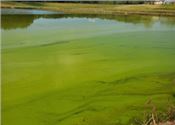|
Practice Caution Around Water This Summer

Keep pets from drinking from or swimming in water that is intensely green or blue-green, and rinse them
in clean water if they do jump in.
Photo by MSU Extension Service
MISSISSIPPI STATE, MISS.
In the age of COVID-19, we do not need more to worry about. However, the summer of 2019 proved that even recreating in your local pond, stream or beach comes at some risk.
We saw a nationwide outbreak of rare, yet severe, maladies that originated from the water. These problems usually start in the hottest part of summer.
The first was a massive cyanobacteria outbreak in the coastal waters of Florida. Millions of fish, marine mammals, sea turtles, birds and other species died. People felt it, too. Respiratory difficulties, headaches, rashes and gastrointestinal distress were commonly reported. Luckily, these outbreaks are usually well reported, and people can avoid affected areas. It is an ecological tragedy, but rarely does it cause loss of human life.
Next came the freshwater cyanobacteria hysteria. One headline read, “TOXIC ALGAE IS SPREADING ACROSS THE U.S.!” What happened is that people’s dogs went swimming in ponds with a toxic bloom. Within a few weeks, dogs died in North Carolina, Georgia, Texas, Louisiana and even Wisconsin.
Millions of dogs, people, cattle and other animals safely use ponds in the summer to cool down. Cyanobacteria are in every pond, but rarely does a toxic bloom occur.
When it does, it can affect any person or animal that comes in contact with it. There is no public warning system, but you can read the signs. If you see dead fish, a thick green or blue-green film on the water, or if the water looks otherwise “yucky,” it is best to use the garden hose to cool off.
Another risk is an organism that sounds like a Harry Potter spell. Pythium insidiosum is a water mold that can cause a rare and deadly disease known as Pythiosis. It enters the body through wounds in the skin or via the mouth. It causes a thickening of stomach and intestinal tissues, with symptoms like fever, vomiting, diarrhea, skin lesions, swollen lymph nodes, and abdominal masses and pain. Pythium is found in almost all surface water, but it rarely infects animals unless they have other underlying conditions.
Possibly the most insidious malady to come from contact with water is a nasty creature known as Naegleria fowleri. You may have heard its other name, the “brain-eating amoeba.” This small creature thrives in very warm to hot fresh water by eating bacteria. However, if it gets up your nose, it is bad news. Once inside you, it moves through the olfactory nerve to the frontal lobe of the brain. It takes 2 to 15 days for symptoms to occur, but once they do, you are dead within a week.
Scary, right? The good news is that this amoeba is incredibly rare. On average, it kills about 3.4 people in the U.S. each year. By comparison, lightning kills 49 per year. Hence, you literally have a much greater chance of being struck by lightning.
So, should you avoid water all summer long? Of course not. Just practice caution. When you are in hot, shallow areas, keep your head above the water. Although ponds that look disgusting are probably perfectly safe, you should avoid them. Do not let your pets drink or swim if the water is intensely green or blue-green, and rinse them in clean water if they do jump in. ∆
|
|